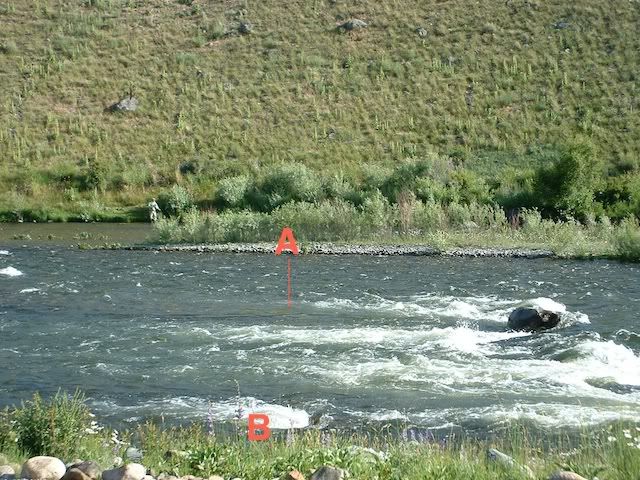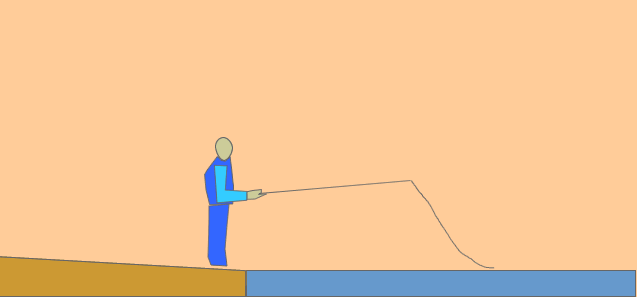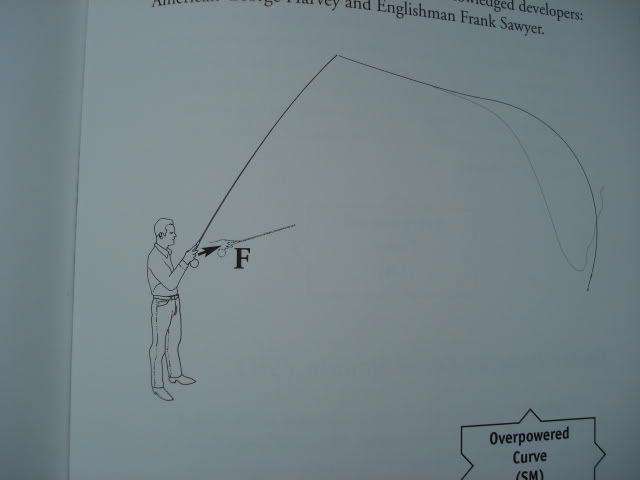silver creek
Well-known member
Here is another post from Jason Borger over on Sexyloops. Again he describes a difficult casting fishing situation in which the trout is feeding in water with extremely complex and unpredictable currents. This is the second time in as many weeks that he has mentioned this cast as a solution to a presentation problem.
Sexyloops - Jelly Water Puzzle
I have come up against similar situations on the Madison. In fact one such location is right in front of Jim Greenlee’s Home.
I remember the day that he told me he would sit on his porch during the evening hatch, and watch angler after angler try to catch the feeding trout as multiple noses poked out of the water. After 30 minutes or so of trying to hook a fish, they would give up. Jim challenged me to catch those trout.
The fish were feeding in the slick “A” behind the large boulder. You cannot wade into that water, it is too deep and too fast. You must cast from position “B” to the feeding fish at “A.”

Here’s view of the spot and Jim’s home from the other side of the Madison. You cannot wade from the other side either. The thin long island on the second photo is below the slick. Float boats would put in above and anchor on the island and then cast up into the slick. That was the only way he saw anyone catch those fish.


That evening, I waited until the trout started feeding and I knew why they had given up. Any straight cast would land the cast on the fast water and be immediately dragged away. I had a blast with those fish. After that evening, Jim named that slot Henry’s run.
There were only two casts/aerial mends (also called in-the-air mends) which had a chance of catching those fish and not 1 out of 10 fly fishers even know of or practice those mends. I had
We should first define our terms.
A CAST is the motion of the rod tip BEFORE the rod stop. A cast positions the line in the air so that it falls straight or curved on the water to position the fly as needed.
An AERIAL MEND is the motion of the rod tip AFTER the rod stop and BEFORE the line lands on the water. An aerial mend repositions the line in the air so that it falls straight or curved on the water to position the fly as needed. For example, a reach mend positions the line to the right or left and in a straight line. A wiggle mend positions the line in curves from the rod tip to the fly. These are two common aerial mends.
An ON THE WATER MEND is the motion of the rod tip AFTER the line lands on the water. An on the water mend repositions the line so as to make the fly perform as a natural. Most of the time it is to prolong a drag free float, but mends can also reposition the line to make a fly skate, or sink faster, or a streamer speed up or change direction.
There are 6 directions the rod tip can move in a 3 dimensional space - up or down, right or left, and forward or backward. Any cast, aerial mend, or on the water mend can be described by a combination of those 6 directions. If we commonly move the rod tip in those 6 directions while doing on the water mends, why do we limit ourselves to the right and left motions of the reach and wiggle aerial mends?
The cast that EVERY fly fisher should practice is the puddle aerial mend (often called a puddle cast but actually a mend since it comes after the rod stop).
A puddle mend is not difficult mend. Basically, if you can do a reach mend, you can do a puddle mend. Think of it this way. In a reach mend you cast straight and mend the rod to one side. On a puddle, just angle that cast up and mend DOWN. It is a wonderful cast that solves a lot of difficult mends across varying current as long as there is open air above the run. The cast will collapse and the fly and leader will fall in a “puddle” with a huge amount of slack.
It takes some judgement to tell where the cast will land after the downward mend, but that will come with doing the cast a few times. The higher you aim the greater the slack that puddles. The ultimate "puddle" would be to cast straight up at 90 degrees and drop the rod tip. All the line and leader would puddle at the end of the rod tip.
Try it. It is a wonderful cast that solves a lot of difficult mends across varying currents. The one place it does not work is where there are overhanging trees or bushes. But in open water, it a wonderful cast.
Since you want most of the slack at the end of the cast, the best puddle cast is performed with an underpowered wide loop that collapses on itself. Think of a forward cast that collapses before it extends; angle that cast up and mend down. To get a puddle at the very end of the leader, direct the cast more in an upward trajectory and widen the loop. You can also slip some line as the cast unfurls to further “kill” the cast.
This is a graphic of the puddle cast. In the graphic, the cast is performed straight which will lay slack along the entire cast, but what we want is most of the slack at the end of the cast. Aiming the cast high over the target and dropping the rod tip piles the line up at the end, especially if you have a wide loop that does not extend fully collapses on itself.

Here is a video of the puddle cast in my terminology but called a pile and puddle cast on YouTube. The pile and parachute are different casts per the Borgers.
https://www.youtube.com/watch?v=O6uHddBAH7g
The second cast that will work if you are using a bushy fly is what the Gary and Jason Borger call the pile cast. It is a cast and not a mend. This is the same cast as the tuck cast but performed with a limber leader/tippet that cannot turn the bushy fly over. It is an overpowered cast that flips the end of the fly line over as in a tuck cast, but the leader cannot turn over the fly and the leader will collapse in a “pile.”
Here is the illustration of the two casts from Jason Borger's book. The Tuck is the more solid line than flips completely over. The Pile shows the trailing distal leader and tippet with the trailing air resistant dry fly.

When one can perform both casts, there is an advantage to the pile cast over the puddle mend. Because the puddle mend is a high trajectory and depends on gravity to puddle the line/leader it is less accurate than the pile. Any wind or gust can make the puddle useless. On the pile cast, the leader lands first and before the line so you get the fly on the water before the line hits the water and pulls on the leader.
Sexyloops - Jelly Water Puzzle
I have come up against similar situations on the Madison. In fact one such location is right in front of Jim Greenlee’s Home.
I remember the day that he told me he would sit on his porch during the evening hatch, and watch angler after angler try to catch the feeding trout as multiple noses poked out of the water. After 30 minutes or so of trying to hook a fish, they would give up. Jim challenged me to catch those trout.
The fish were feeding in the slick “A” behind the large boulder. You cannot wade into that water, it is too deep and too fast. You must cast from position “B” to the feeding fish at “A.”

Here’s view of the spot and Jim’s home from the other side of the Madison. You cannot wade from the other side either. The thin long island on the second photo is below the slick. Float boats would put in above and anchor on the island and then cast up into the slick. That was the only way he saw anyone catch those fish.


That evening, I waited until the trout started feeding and I knew why they had given up. Any straight cast would land the cast on the fast water and be immediately dragged away. I had a blast with those fish. After that evening, Jim named that slot Henry’s run.
There were only two casts/aerial mends (also called in-the-air mends) which had a chance of catching those fish and not 1 out of 10 fly fishers even know of or practice those mends. I had
We should first define our terms.
A CAST is the motion of the rod tip BEFORE the rod stop. A cast positions the line in the air so that it falls straight or curved on the water to position the fly as needed.
An AERIAL MEND is the motion of the rod tip AFTER the rod stop and BEFORE the line lands on the water. An aerial mend repositions the line in the air so that it falls straight or curved on the water to position the fly as needed. For example, a reach mend positions the line to the right or left and in a straight line. A wiggle mend positions the line in curves from the rod tip to the fly. These are two common aerial mends.
An ON THE WATER MEND is the motion of the rod tip AFTER the line lands on the water. An on the water mend repositions the line so as to make the fly perform as a natural. Most of the time it is to prolong a drag free float, but mends can also reposition the line to make a fly skate, or sink faster, or a streamer speed up or change direction.
There are 6 directions the rod tip can move in a 3 dimensional space - up or down, right or left, and forward or backward. Any cast, aerial mend, or on the water mend can be described by a combination of those 6 directions. If we commonly move the rod tip in those 6 directions while doing on the water mends, why do we limit ourselves to the right and left motions of the reach and wiggle aerial mends?
The cast that EVERY fly fisher should practice is the puddle aerial mend (often called a puddle cast but actually a mend since it comes after the rod stop).
A puddle mend is not difficult mend. Basically, if you can do a reach mend, you can do a puddle mend. Think of it this way. In a reach mend you cast straight and mend the rod to one side. On a puddle, just angle that cast up and mend DOWN. It is a wonderful cast that solves a lot of difficult mends across varying current as long as there is open air above the run. The cast will collapse and the fly and leader will fall in a “puddle” with a huge amount of slack.
It takes some judgement to tell where the cast will land after the downward mend, but that will come with doing the cast a few times. The higher you aim the greater the slack that puddles. The ultimate "puddle" would be to cast straight up at 90 degrees and drop the rod tip. All the line and leader would puddle at the end of the rod tip.
Try it. It is a wonderful cast that solves a lot of difficult mends across varying currents. The one place it does not work is where there are overhanging trees or bushes. But in open water, it a wonderful cast.
Since you want most of the slack at the end of the cast, the best puddle cast is performed with an underpowered wide loop that collapses on itself. Think of a forward cast that collapses before it extends; angle that cast up and mend down. To get a puddle at the very end of the leader, direct the cast more in an upward trajectory and widen the loop. You can also slip some line as the cast unfurls to further “kill” the cast.
This is a graphic of the puddle cast. In the graphic, the cast is performed straight which will lay slack along the entire cast, but what we want is most of the slack at the end of the cast. Aiming the cast high over the target and dropping the rod tip piles the line up at the end, especially if you have a wide loop that does not extend fully collapses on itself.

Here is a video of the puddle cast in my terminology but called a pile and puddle cast on YouTube. The pile and parachute are different casts per the Borgers.
https://www.youtube.com/watch?v=O6uHddBAH7g
The second cast that will work if you are using a bushy fly is what the Gary and Jason Borger call the pile cast. It is a cast and not a mend. This is the same cast as the tuck cast but performed with a limber leader/tippet that cannot turn the bushy fly over. It is an overpowered cast that flips the end of the fly line over as in a tuck cast, but the leader cannot turn over the fly and the leader will collapse in a “pile.”
Here is the illustration of the two casts from Jason Borger's book. The Tuck is the more solid line than flips completely over. The Pile shows the trailing distal leader and tippet with the trailing air resistant dry fly.

When one can perform both casts, there is an advantage to the pile cast over the puddle mend. Because the puddle mend is a high trajectory and depends on gravity to puddle the line/leader it is less accurate than the pile. Any wind or gust can make the puddle useless. On the pile cast, the leader lands first and before the line so you get the fly on the water before the line hits the water and pulls on the leader.
